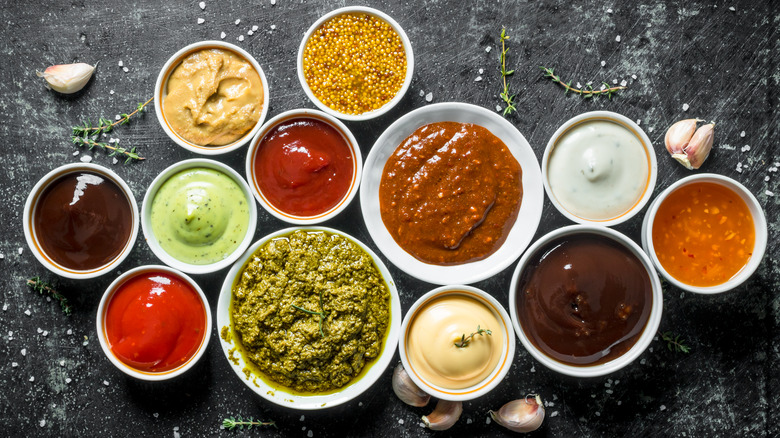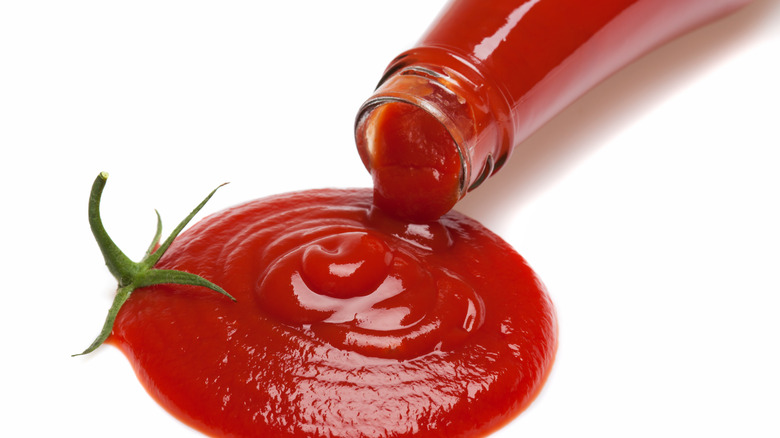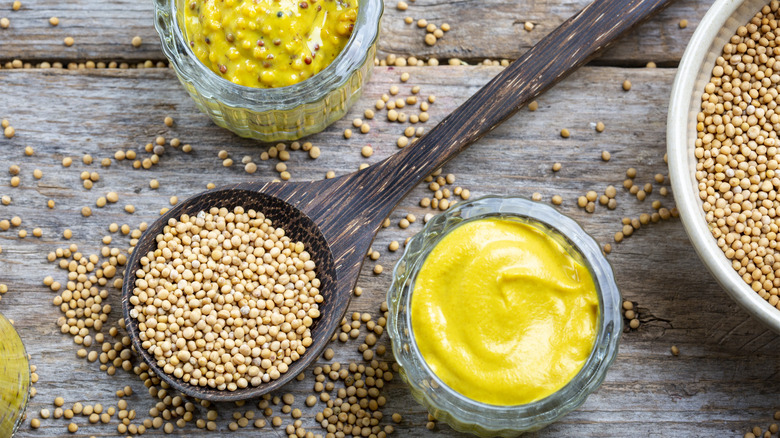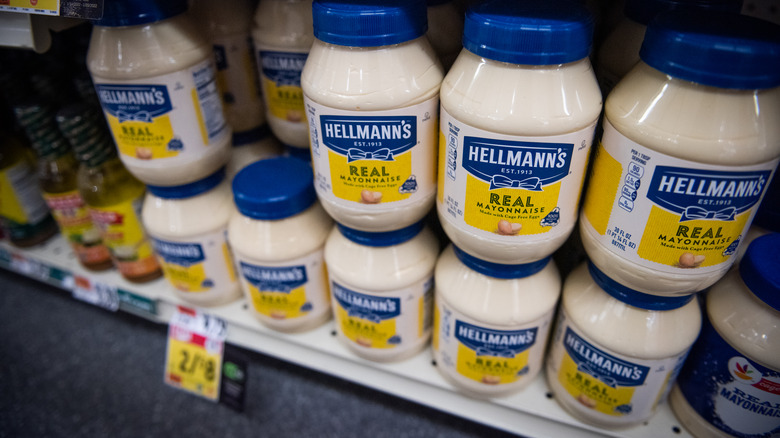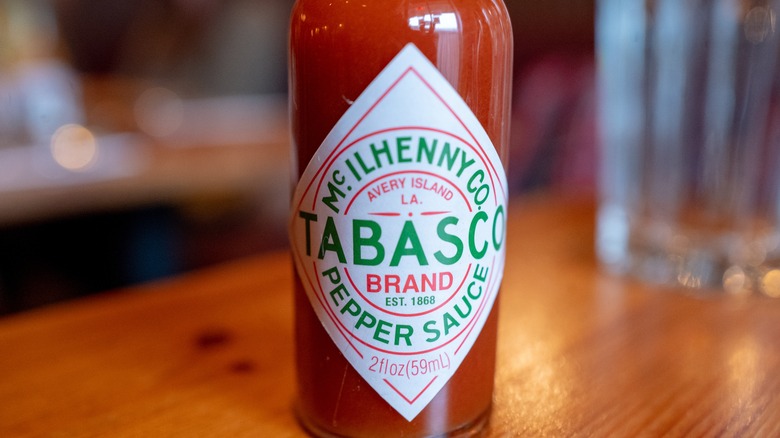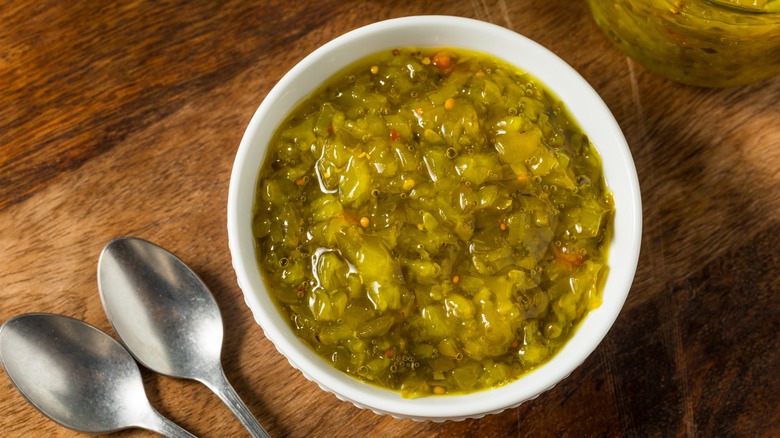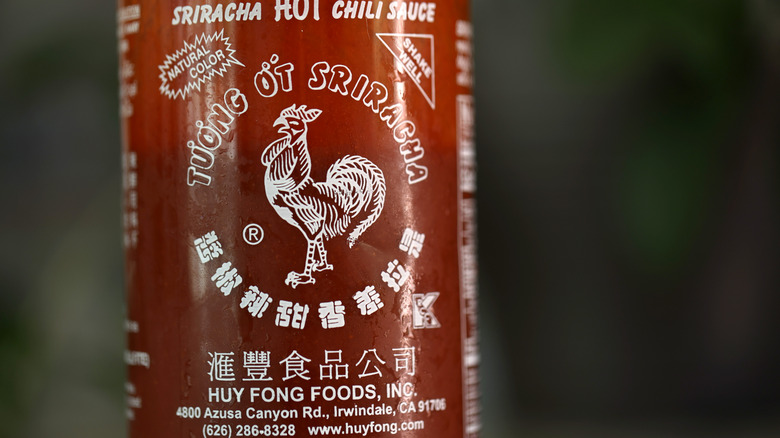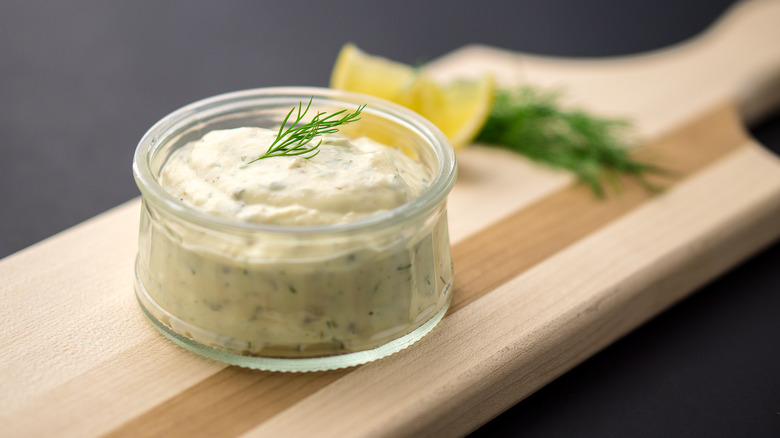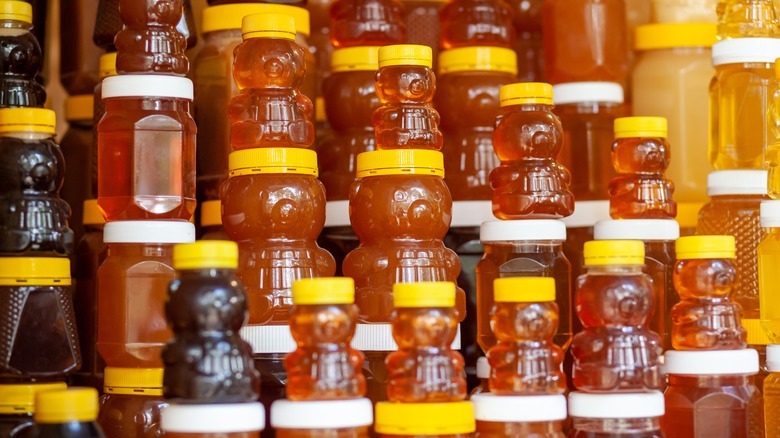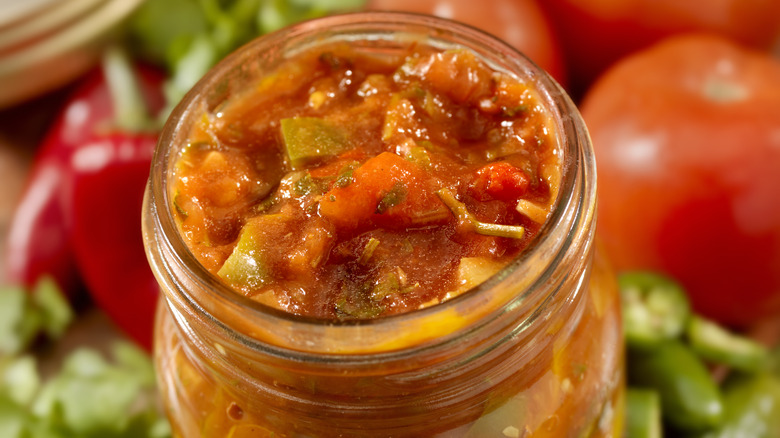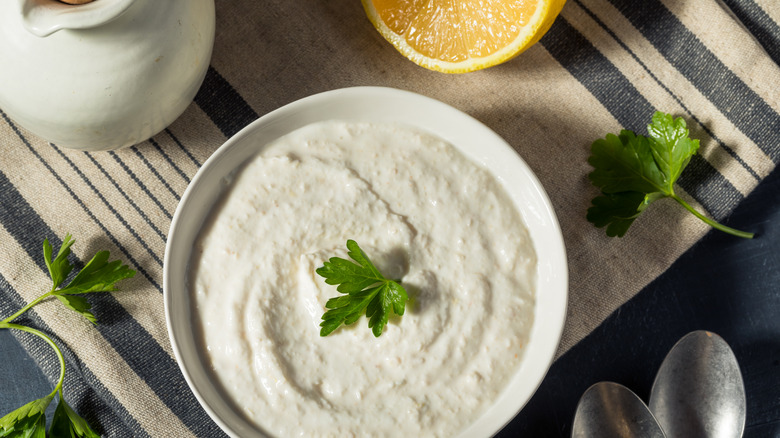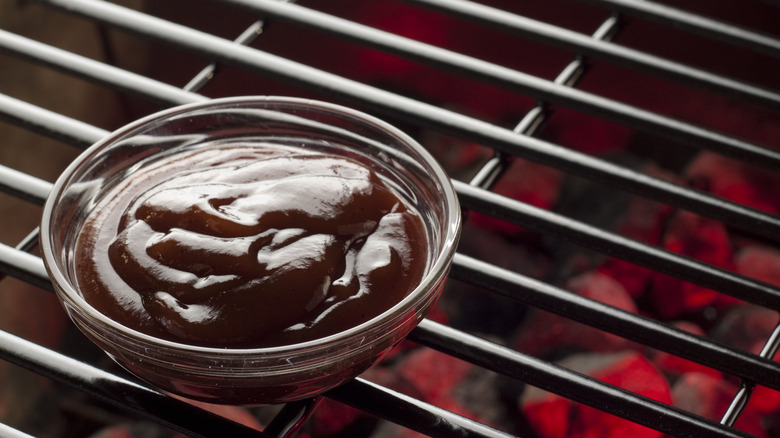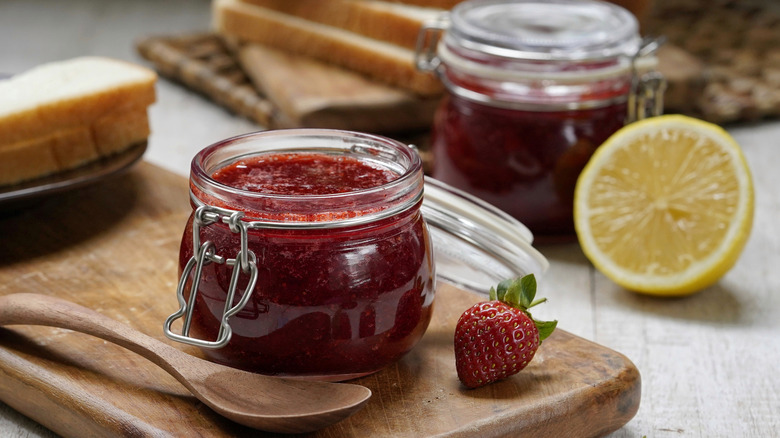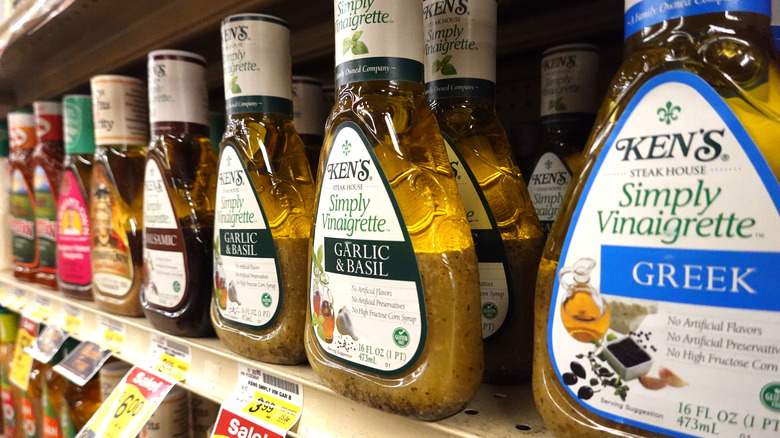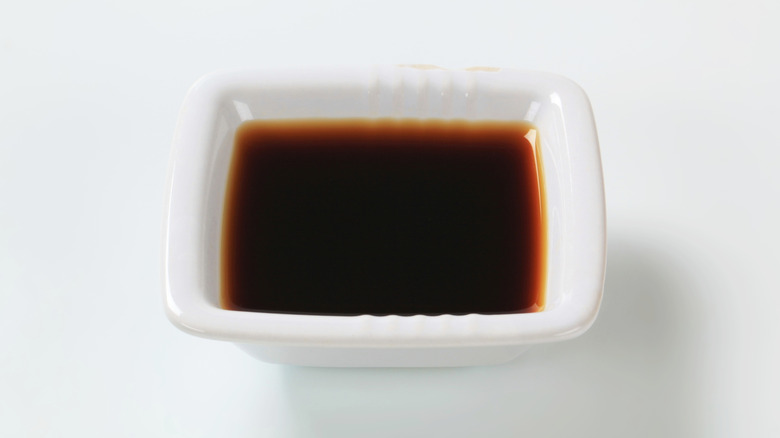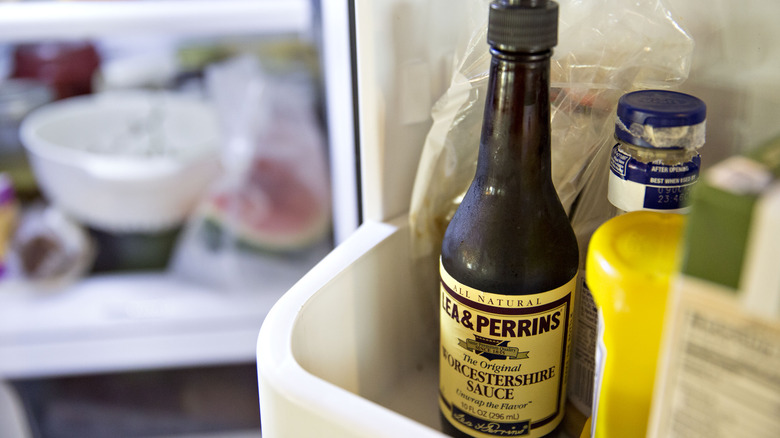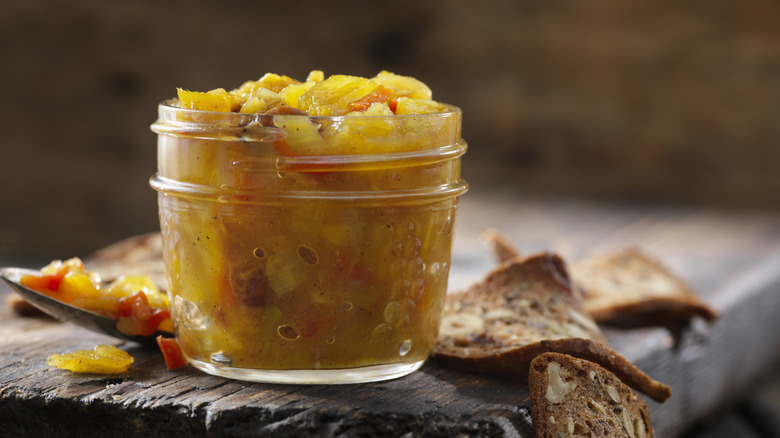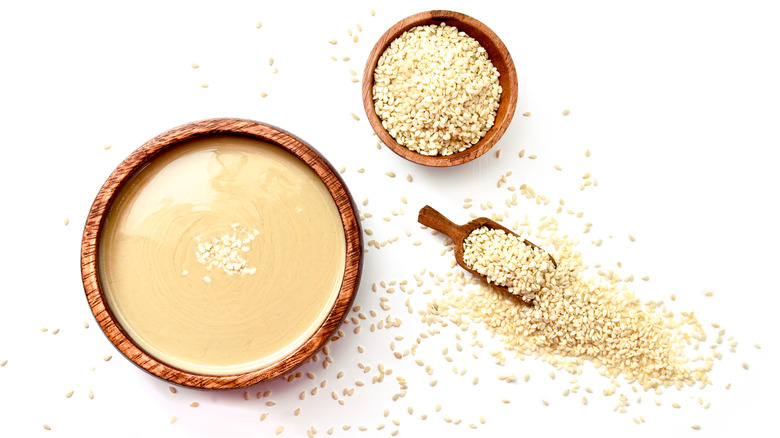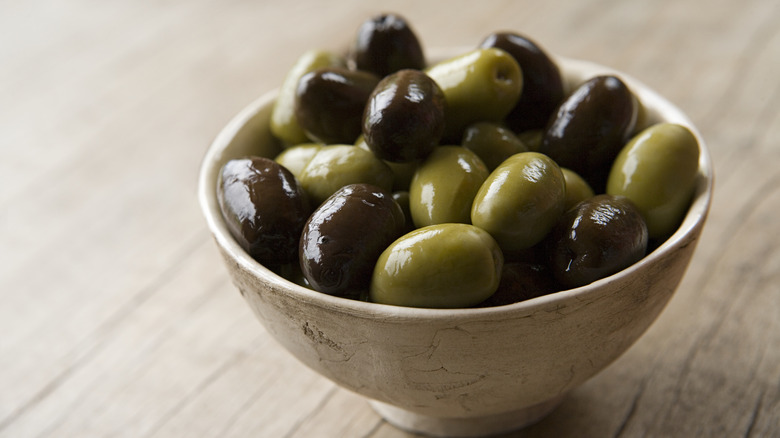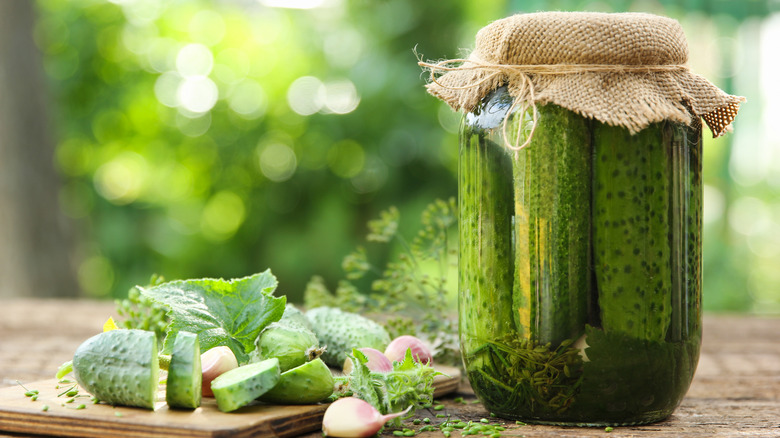How Long Do Condiments Last?
Condiments are the zest of life that our food needs. Whether it's slathering ketchup or mustard on a freshly grilled burger or making yourself a simple breakfast of toast with fruit preserves, it's clear that these items are invaluable to have in the fridge or the pantry. If you ask someone how long you should keep a jar of mayonnaise or homemade relish around, you're likely to get a slew of different answers and inevitably resort to a taste test.
Generally, condiments are made to last. While other pantry staples like bread, eggs, and meat may only last a week, condiments are made with ingredients like sugar, salt, and acid to provide flavor and deter pesky foodborne illnesses from colonizing the food. As a result of the inhospitable conditions, many condiments can last several months — and even years — without having to be thrown out.
The best policy for any condiment is to follow the recommended refrigeration protocol on the container. Since the shelf life of most products depends on when the seal is cracked, it's best to label each bottle with the date it should be thrown out. Not only will this cut down on clutter, but it will prevent you from eating expired food that may make you sick. Here are some of the most popular condiments and how long each typically lasts.
1. Ketchup
Ketchup is a kitchen essential for meatloaf, eggs, and french fries. Unopened ketchup can last up to a year on the shelf, while opened bottles should be refrigerated and used within six months. Although ketchup can technically last on the counter because of its high acidity, the shelf life is dramatically shortened and its quality will go downhill. Restaurants can get away with keeping ketchup out because the bottle turnaround time is relatively short compared to household use.
It's relatively easy to know when ketchup has gone bad. Old ketchup will start to stratify into layers and may change to a darker, more maroon color rather than the bright red hue of fresh ketchup. Although ketchup is still safe to eat when the product starts exhibiting these mild changes, you are better off tossing the bottle and getting a new one.
2. Mustard
Ketchup may be the condiment always in the limelight, but mustard is the true champion of barbecues and cookouts. This blend of mustard seeds and vinegar can last in the pantry for one to two years unopened, and about a year in the refrigerator once the seal is broken. Like other types of condiments, the acidic conditions of this product make it relatively safe to eat if it's left on the counter, but it is advised that consumers refrigerate the bottle between use for maximum quality.
Certain types of mustard, like Dijon or horseradish, will lose their flavor incredibly quickly if not refrigerated. Not only will the variety impact the estimated shelf life, but the package the mustard is in, too. French's mustard, for example, will last 18 months from the date of manufacture if stored in a plastic squeeze bottle but up to 24 months in a glass jar.
3. Mayonnaise
Mayonnaise is one of the more perishable condiments because it contains eggs. Commercially packaged mayonnaise can last three to six months on the shelf before opening and two months after. Some mayonnaise bottles (like Hellman's Real Mayonnaise squeeze bottle) do not require refrigeration after opening, while other mayonnaise products recommend refrigeration on their packaging. Moreover, government agencies recommend refrigerating anything perishable, so although mayonnaise may not need to be refrigerated, there's no harm in doing so.
Homemade mayonnaise follows a slightly different trajectory. Since this version contains no preservatives, it should be refrigerated immediately after use and eaten within four days. Since the shelf life of this condiment is especially short, we recommend labeling it with a "use-by" date to ensure no one in your household gets sick.
4. Hot sauce
Hot sauce lovers, you're in luck! This condiment has one of the longest shelf lives. Ingredients like spicy chile peppers and vinegar make most hot sauces inhospitable to foodborne illnesses, but not all sauces are created equal. Hot sauces with more added ingredients tend to have a varying shelf life, while brands that stay true to the basic hot sauce ratio can last much longer. Hot sauce can last a minimum of six months at room temperature once opened, but once refrigerated, it can last upwards of one to two years.
If the main ingredient in the hot sauce is vinegar, it is likely permissible to store it at room temperature. But hot sauces containing fruits like mango or pineapple, or ones made "all-natural" without sodium benzoate, vinegar, or lemon juice, should have a one-way ticket to your fridge.
5. Relish
Relish is a relatively odd condiment that only really appears on a hot dog. As a result, you probably have a bottle of relish in your fridge that remains mostly untouched outside of barbecue season. Relishes can last up to 30 months in the pantry unopened or nine months after being opened and refrigerated.
Relish's long shelf life is credited to the use of vinegar, which lowers the pH of the product. Although homemade relish often uses vinegar, it does not have any additional preservatives to help ward off bacteria. Therefore, this DIY product may only last a few days in the fridge. The type of relish also impacts its shelf life; dill relish, for example, might last close to two years, while sweet relish only stays fresh for about a year. Packaging and storage conditions might also affect how long before it goes bad.
6. Sriracha
Sriracha has an impressively long shelf life at two years past the "best by" date if left unopened. Once opened, the refrigerated bottle should be used within six to nine months for optimal quality, but it can potentially last upwards of a year. As the sriracha ages, it will begin to discolor and turn brown, but this is not a sign that it has gone bad. Refrigeration, although unnecessary due to the pepper's capsicum, vinegar, and preservatives like sodium bisulfate, will preserve the flavor of this hot sauce and slow discoloration.
It's best to use your senses to determine if it's time to throw out your sriracha bottle. Sriracha that has gone bad may appear brown (different from the maroon shade of old sriracha) or emit a foul odor.
7. Tartar sauce
Tartar sauce is a tangy condiment made with egg yolks, pickle juice, relish, and herbs; it's the perfect creamy addition to summer seafood dishes like fried clams. Because tartar sauce is made with a mayonnaise base, it has a similar shelf life of up to six months after opening. This condiment can last upwards of 12 to 18 months in the pantry unopened and should always be refrigerated after opening for maximum quality. Tartar sauce that has gone bad will discolor into a pink or orange hue and will be watery.
Since tartar sauce is loaded with preservatives and acidic ingredients, the estimated shelf life is for quality purposes rather than safety. Depending on the homemade recipe you use, the estimated "best-by" date for DIY tartar sauce is between a week and two weeks.
8. Honey
Honey is a condiment often heralded as having an indefinite shelf life. This is because honey contains high concentrations of natural sugars and acidic properties, making it a poor environment for bacteria to flourish.
This sweet spread lasts about a year in your pantry and will diminish in quality after that. Old honey will start to cloud or crystallize, but this can be easily reversed by heating it in a pan of hot water or microwaving it. However, repeatedly doing this will cause the honey to lose some of its nutritional value and change its chemical composition. Proper storage, like in an airtight container like the one it came in, in a dark space in your pantry, will help keep this product usable for as long as possible. Although refrigeration is the go-to for many condiments, it is not recommended for honey. If you refrigerate honey, it will crystalize faster.
9. Salsa and taco sauces
Do you think of salsa as a dip or a condiment? Since it's the quintessential topping for tacos, we're going to go with condiment on this one. Salsa and taco sauces generally share the same storage parameters. Shelf-stable commercial salsa, like the kind you'd get from the chip aisle at the grocery store, can last up to a year in your pantry without being opened. After it's opened, though, you'll have a narrow window to eat it before it goes bad. Commercial salsa brands only last two to four weeks after opening and should always be observed for signs of mold or funky odors.
Non-commercial salsa has a different shelf life. Fresh salsa lasts four to seven days in the fridge, while homemade, properly-sealed, canned salsa can last between nine to 12 months in the pantry.
10. Horseradish
Since horseradish sauce is inhospitable to most tastebuds, it's likely not a friendly place for bacteria, right? A jar of horseradish will last about a year in the refrigerator unopened or about three to four months once the seal has been broken. Horseradish should always be stored in the refrigerator rather than the pantry to help the root retain its zesty flavor. Whole fresh horseradish only lasts one to two weeks in the refrigerator. Alternatively, the root can be frozen to maintain its longevity.
Horseradish sauce, which contains the root and dairy products like sour cream, has a shelf life of three to four months after opening. Like other perishable spreads, horseradish sauce should be kept in the fridge when not in use and monitored for signs of mold before use.
11. Barbecue sauce
Barbecue sauce is a medley of different condiments, like ketchup and Worcestershire sauce, so it has a similar shelf life. Homemade or canned barbecue sauce will last nine to 12 months in the pantry unopened, while bottled, commercial barbecue sauce will last upwards of a year in the fridge unopened.
Like other condiments, it is recommended that barbecue sauce be refrigerated after opening. The optimal quality of commercial barbecue sauce diminishes within four to five months of opening, so it is recommended that you use up your bottled sauce ASAP. Some brands have different variations in shelf life. Stubb's Bar-B-Q sauce, for example, can last three years on the shelf unopened but only last up to eight weeks in the fridge after opening. Homemade barbecue sauce that is not correctly canned will only last one week in the refrigerator, so it's best to concoct the fresh stuff right before you slather it on your ribs.
12. Jams and jellies
There is a significant variation in the shelf life of jams and jellies because these products contain varying sugar and acid levels. Commercially-packaged jams, jellies, and preserves have an unopened shelf life of around six to 18 months, depending on the product. Once opened and refrigerated, the products can last about six months.
You can leave an open jar of jam on your counter or pantry for about one month before you need to throw it out. This is because most preserves have a low pH, thus, are not a conducive environment for bacteria growth. The preserves also have a much lower water quantity than other perishable goods, which in turn makes them less prone to spoilage. If you store your jam in the pantry, try to keep it in a cool, dark place.
13. Salad dressing
Salad dressing has a considerable variation in estimated shelf life because of the variety of dressing styles. Vinaigrettes, for example, are highly acidic, while mayo-based dressings like ranch and blue cheese contain more perishable ingredients. As a rule of thumb, opened salad dressings should be eaten within two months. If left unopened, you can expect these salad dressings to last anywhere from 10 to 12 months.
Like other homemade food products, homemade salad dressing has a shorter shelf life than commercial versions. The quick way to tell if homemade salad dressing has expired is by looking for clear separation in a mayo-based dressing or a rancid smell for vinaigrettes. Homemade creamy dressings will only last three to four days, while vinaigrettes can remain viable for up to a few weeks.
14. Soy sauce
Soy sauce is a hardier condiment than you'd think. Unopened soy sauce and teriyaki sauce can last up to three years in the pantry. In addition, you don't have to refrigerate soy sauce because the lactic acid bacteria are cultured during fermentation in a salty and low-oxygen environment, which discourages microorganism growth. Refrigerating soy sauce is merely a matter of preference and produces a similar shelf life after opening — around two to three years. An odd odor or viscous consistency is a sign that it's time to throw your soy sauce out and start fresh.
For optimal flavor, Kikkoman recommends its customers use their soy sauce within a month of purchasing. But unless you're making soy marinades constantly or eating sushi every night, it's unlikely anyone will make their way through a soy sauce container within this window.
15. Worcestershire sauce
Don't worry — we won't ask you to pronounce it. Worcestershire sauce is shelf-stable and can last a year in the pantry unopened. This long shelf life results from fermentation with ingredients like vinegar, sugar, and molasses. This produces a thick texture, tangy consistency, and an environment where pathogens can't survive and reproduce.
It could be stored in the refrigerator, but its composition makes this storage decision a matter of personal preference rather than a necessity. If you don't refrigerate Worcestershire sauce after opening, you may find that it has a marginally shorter shelf life; storing it in the refrigerator may boost its shelf life by up to three years. Since Worcestershire sauce already has a unique aroma and flavor, eaters need to use their sleuthing skills to identify any changes that may suggest the sauce has gone bad.
16. Chutney
Chutney may not be a popular condiment choice for barbecue favorites, but it does have applications for Indian recipes, charcuterie, and meats. Although it shares the same qualities as a relish, a chutney is made with fruit instead. This spread can last up to a year sealed in the pantry, or up to two months opened in the refrigerator.
Chutney is often homemade rather than store-bought. Once opened, it is recommended that homemade chutney be eaten within four weeks. Some ingredients can extend the shelf life of chutney, including natural additives like oil, salt, mustard, or hot peppers. Adding apple cider vinegar can also be used to ward off pathogens and brighten the fruit flavor of the spread. Alternatively, chutney can be frozen in an ice cube tray with some oil to keep it viable for longer.
17. Tahini
Tahini is a versatile sesame seed spread perfect for adding to salad dressings, stir fry sauces, or sprinkling on a fresh-fried falafel. Because it is almost pure fat, an unopened tahini bottle can last up to a year in the pantry. It is recommended to store tahini in a refrigerator because it will slow the natural separation of oil. However, tahini is shelf-stable both in a refrigerator and at room temperature.
Although the oil separation may cause you to think twice about tossing your tahini in the trash, it's important to note that this is common among all kinds of natural nut and seed butter because there is no oil to help homogenize the mixture. If you notice your tahini starting to stratify, mix it with a spoon or an immersion blender or store the container upside down.
18. Olives
Olives are like a condiment for your cocktails. Bar olives, which are purchased fresh, should always be kept refrigerated after opening and typically last about two weeks before needing to be thrown out. Unopened black and green olives last between 12 and 18 months in the pantry. For maximum longevity, the olives should be fully submerged in the salty brine or oil to retain optimal taste and quality — plus, it will slow the growth of any lingering bacteria or pathogens.
You can tell if olives have gone bad by looking for an off-putting smell from the brine or the olives themselves or visible signs of mold. Discoloration isn't an accurate indicator of whether the olives need to get thrown out, so you'll have to rely on your other senses to lend a hand.
19. Pickles
There isn't a condiment that comes quite close to pickles. An unopened, unrefrigerated jar can sit in a pantry (out of the sunlight) for up to a year. Once the pickle jar has been broken, the shelf life is between one and three months. Pickles made with a highly-acidic vinegar brine tend to last longer, but this will ultimately make your pickles taste sourer and, depending on your pickle preference, potentially inedible.
You can store an open jar of pickles on the counter, but it is not recommended for long-term storage. The cool refrigerator temperature will help slow the fermentation process and will help your beloved pickles retain their flavor. To avoid introducing mold to your pickle jar, always use a pair of tongs rather than your fingers to grab a pickle from the jar.
